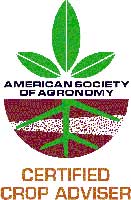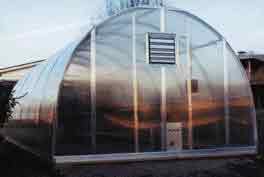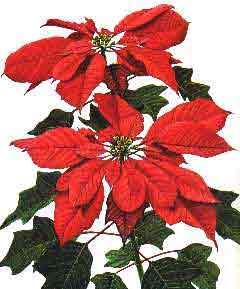Kentucky Pest News Newsletter
HIGHLIGHTS IN THIS ISSUE
Number 902__________ Nov 20, 2000
TOBACCO
GREENHOUSE
ANNOUNCEMENTS
KENTUCKIANA CROP PRODUCTION SEMINAR
By Lee Townsend
 The annual Kentuckiana Crop Production Seminar
will be held December 12 - 13, 2000 at the Radisson
Hotel, Evansville, IN. A CCA continuing education
program, three hours of continuing education credit
in either cropping systems management or soil and
water management, starts at 8 am. The Crop
Production Seminar runs from 1 pm to 5:10 pm on
December 12 and from 8 am until noon on December
13. The program will be submitted to the Division of
Pesticides Ky Department of Agriculture for
continuing education credit for commercial pesticide
applicators (Categories 1, 10 and 12).
The annual Kentuckiana Crop Production Seminar
will be held December 12 - 13, 2000 at the Radisson
Hotel, Evansville, IN. A CCA continuing education
program, three hours of continuing education credit
in either cropping systems management or soil and
water management, starts at 8 am. The Crop
Production Seminar runs from 1 pm to 5:10 pm on
December 12 and from 8 am until noon on December
13. The program will be submitted to the Division of
Pesticides Ky Department of Agriculture for
continuing education credit for commercial pesticide
applicators (Categories 1, 10 and 12).
Click here for the agenda.
TOBACCO
TOBACCO DISEASE CONTROL PLANNING SHOULD BE A PRIORITY
By William Nesmith

Having a sound, long-term and short-term disease
control plan and carrying it out are keys to reducing
losses from infectious diseases in tobacco
production. It is very common during the growing
season, especially after transplanting, for producers
to face a disease situation where they can do very
little, or nothing at all, at that particular time and
place to reduce losses from infectious disease. This
is because the tools to rescue tobacco crops from
diseases are, in general, not available. Conversely,
it is rare to find a situation where options were not
available before the season started that would have
greatly reduced losses had they been incorporated
before the season started. Therefore, the lesson to
understand is that controlling tobacco diseases
centers around using preventive measures, and
prevention requires advance planning.
I urge County Extension Agents and dealers to
stress this need for proper planning and follow-
through with disease prevention in educational
programming and advertisements. Each grower
needs to make it a priority to assess the disease
threats for each and every field on a case-by-case
basis as the first step in disease control for their 2001
crop, and future crops.
Disease potentials and risks change from year to
year, and the outcome can be greatly impacted by
the decisions made and the timing of controls.
Growers are most likely to make the correct
decisions when they take steps to become very
informed about their particular disease situations -
and to the level that they understand key facts about
the disease and how to implement the controls.
Without growers having such understanding, the
probability is high that they will reject the very
controls needed for the particular situation, because
the controls usually require change, they are not
cheap, or sometimes they are not easy to use - so it
is human nature to resist them.
Having a sound disease control plan and carrying it
out are keys to reducing losses from black root rot,
black shank, tobacco stunt, Fusarium wilt, blue
mold, nematodes, and viruses. I recommend that
growers make it a priority to assess the disease
threats for each of these diseases for every field on a
case-by-case basis as the first step in disease control
for the 2001 crop. Here are some pointers to
consider:
- Make an itemized list of the disease history and
risks associated with each and every field. Use it
during the planning and execution phases of
production.
- Take steps to prevent disease carry-over in the
field from the previous season by using rotation
and good sanitation. No single tool controls
more diseases than proper crop rotation.
- Know the level of disease resistance among all
varieties, new or old, in your system and use the
appropriate variety for the site and situation.
Resistant varieties are especially helpful in
reducing losses from black root rot, black shank,
the Poty-Virus Complex, Tobacco Mosaic Virus,
and Fusarium Wilt. Unfortunately, there is no
one variety with resistance to all these diseases -
another reason to carefully consider the
situation and count the costs and benefits. Some
varieties have more tolerance to blue mold than
others, but those with high resistance have other
short comings that need to be carefully
considered.
- Avoid introducing diseases into your crop and
region on transplants by using healthy
transplants. They will not be healthy if
contaminated trays are used. The fungicide
Terrazole/Terramaster is now labeled in
Kentucky for adding to the float-water to
control Pythium root rot. This is a very valuable
tool and the only chemical labeled for addition
to the float water for disease control. Ferbam
and Dithane are the only fungicides labeled for
foliar disease control in the float production
system. They are effective when used as
preventives, but almost useless in rescue
situations.
- Manage greenhouses and float beds carefully to
avoid moisture on the foliage of plants. Have
aggressive sanitation in all phases of the
systems from start to completion.
- Use the appropriate regimen of preventive
fungicides for the problems present with your
crop. Ridomil Gold and Ultra Flourish are
valuable tools in black shank control, but need
to be used as close to transplanting as possible
and at layby. On some sites, cultivation
applications are also needed. For blue mold
control, Acrobat MZ has proven to be highly
effective, but it must be applied well and
frequently. A new blue mold control tool will
be in the tool box this year - Actigard. This is not
really a fungicide (killer of fungi); instead, it is a
plant inducer - turning on the plant's natural
disease control mechanisms. This chemical has
performed well in reducing losses from blue
mold in extensive tests. But, it must be coupled
with other controls and applied carefully to
avoid serious phytotoxicity problems associated
with turning on the mechanism too early, and to
maximize control. For best results, understand
how it works and what you are doing with it,
before attempting to use it.
- Know the benefits and risks associated with
each cultural practice in your cropping system.
Seldom are production steps disease-neutral.
Some will favor one disease while controlling
another, for example.
- Seek and obtain sound advice! There is an
abundance of advice available to producers, but
some is better than others. Too often, however,
the advice comes with strong bias associated
with what drives our marketing systems -
money. It is especially common for the advisor
to give only "half" the story, that which benefits
their side of the issue, when the growers usually
need the "whole story".

GREENHOUSE

GREENHOUSE FLORAL CROPS - MANAGEMENT OF GRAY MOLD AND POWDERY MILDEW
By John Hartman
Greenhouses producing floral crops such as
poinsettias, roses, and snapdragons provide an ideal
environment for many fungal diseases. Fungal
diseases such as gray mold and powdery mildew
can occur seemingly without warning and quickly
cause widespread damage to these crops.
Gray mold. Caused by the fungus Botrytis cinerea,
gray mold is very common and widespread on the
flowers and buds of many greenhouse flower crops,
and is sometimes associated with stem and leaf rots
or other damage. Symptoms may include rotting of
buds, flowers, or flower stalks, or an off-white or
brown petal spotting. These symptoms are often
associated with tan or gray moldy growth of the
fungus. The fungus spreads rapidly by means of
airborne conidia and can persist in soil as survival
bodies called sclerotia or as a saprophyte on plant
debris. The fungus produces spores and causes
infections when greenhouse humidity is very high
and when leaves are moist. Disease development is
rapid when plants are crowded and poorly
ventilated.
Powdery mildew. The fungus Oidium seen on
greenhouse crops is the typical imperfect stage of
several different powdery mildews. The specific
powdery mildew fungus for each crop is usually
different even though the symptoms of each type
are pretty much the same. Disease symptoms are
very distinct and powdery fungal signs are readily
seen on leaves, shoots, buds, flowers, and poinsettia
bracts. Fungal mycelium and conidia may be found
on both tops and undersides of the leaves. Once the
disease gets started, it is capable of "exploding" so
rapidly that plants appear to be "flocked" within just
a few weeks. Cool (daytime temperatures
remaining less than 85 F) and moist greenhouse
environments, with crowded plants favor rapid
disease development. Based on work done in
Michigan, large numbers of powdery mildew spores
are released in mid-day as the relative humidity
fluctuates in the greenhouse. Greenhouse relative
humidity fluctuations are often associated with
watering.
Control. Good gray mold and powdery mildew
control is mostly synonymous with good cultural
practices. Growers need to remember to:
- Inspect plants frequently, carefully examining at
least one in thirty for disease symptoms and
signs, or one in ten if conditions favor the
disease.
- Remove and destroy dead and dying plant
material. Moribund tissues are easily colonized
by Botrytis and the fungus spreads more easily
to green, healthy tissues. Significant gray mold
control can occur by picking off and discarding
dead leaves and spent flowers.
- Carefully remove powdery mildew infected
leaves while disease levels are still low.
- Provide good spacing between plants on the
greenhouse bench.
- Move air through the crop with the ventilation
system. Improved ventilation reduces both gray
mold and powdery mildew.
- Avoid splashing water on foliage.
- Use heat in the evening to reduce relative
humidity. Gray mold development requires
high humidity in the greenhouse. As air cools
at night, moisture in the air condenses on the
plants unless it is heated.
- For gray mold, fungicides containing
azoxystrobin (Heritage), chlorothalonil (Daconil
2787, Exotherm Termil), copper hydroxide plus
mancozeb (Junction), fenhexamid (Decree),
fludioxonil (Medallion), iprodione (Chipco
26019), thiophanate-methyl (Cleary's 3336,
Domain), trifloxystrobin (compass), or
vinclozolin (Ornalin) may be used.
- For powdery mildew, fungicides containing
azoxystrobin (Heritage), chlorothalonil plus
thiophanate-methyl (Benefit, ConSyst), copper
sulfate with organic component (Phyton 27),
kresoxim-methyl (Cygnus), mancozeb plus
thiophanate-methyl (Duosan, Zyban),
myclobutanil (Systhane), petroleum oils
(Sunspray Ultrafine Spray Oil), piperalin
(Pipron), thiophanate-methyl (Cleary's 3336,
Domain, Fungo-Flo), triadimefon (Strike),
trifloxystrobin (Compass), or triflumizole
(Terraguard) may be used.
- Fungi can develop resistance to azoxystrobin,
iprodione, kresoxim-methyl, thiophanate-
methyl and trifloxystrobin. Even though
fungicide resistance is not common here, it can
occur locally because greenhouse plants are
shipped into Kentucky from many places.
Plants harboring fungicide-resistant fungi could
become established any time. Look for
fungicide resistance and make changes in
cultural practices or fungicide chemistry as
needed. Resistance to benomyl (formerly used
in the greenhouse) also confers resistance to
thiophanate-methyl; resistance to vinclozolin
and iprodione may also be linked.
- Read and follow fungicide label directions before
use. Be sure that the crop being grown is listed on
the label. If a grower has not previously used a
particular fungicide, it needs to be tried out on a few
plants at first. Some fungicides may be phytotoxic
under some conditions.
Lee Townsend
Extension Entomologist
BACK
TO KY PEST NEWS HOME
 The annual Kentuckiana Crop Production Seminar
will be held December 12 - 13, 2000 at the Radisson
Hotel, Evansville, IN. A CCA continuing education
program, three hours of continuing education credit
in either cropping systems management or soil and
water management, starts at 8 am. The Crop
Production Seminar runs from 1 pm to 5:10 pm on
December 12 and from 8 am until noon on December
13. The program will be submitted to the Division of
Pesticides Ky Department of Agriculture for
continuing education credit for commercial pesticide
applicators (Categories 1, 10 and 12).
The annual Kentuckiana Crop Production Seminar
will be held December 12 - 13, 2000 at the Radisson
Hotel, Evansville, IN. A CCA continuing education
program, three hours of continuing education credit
in either cropping systems management or soil and
water management, starts at 8 am. The Crop
Production Seminar runs from 1 pm to 5:10 pm on
December 12 and from 8 am until noon on December
13. The program will be submitted to the Division of
Pesticides Ky Department of Agriculture for
continuing education credit for commercial pesticide
applicators (Categories 1, 10 and 12).

